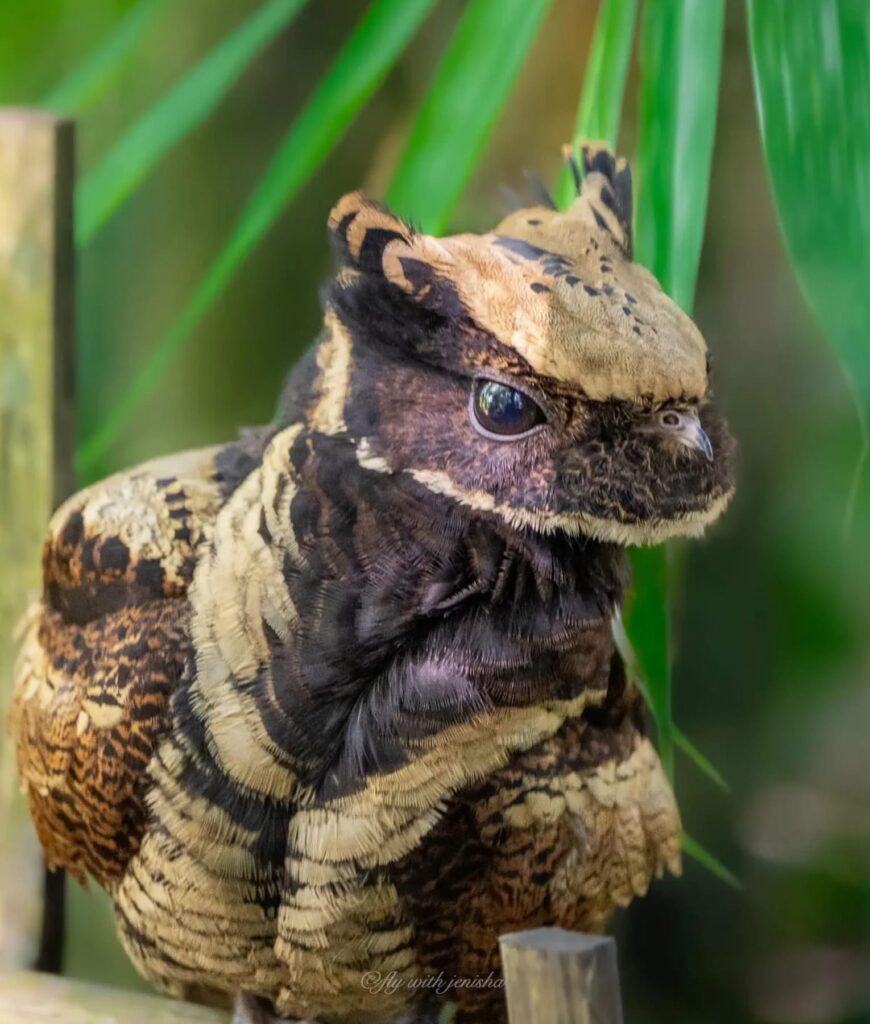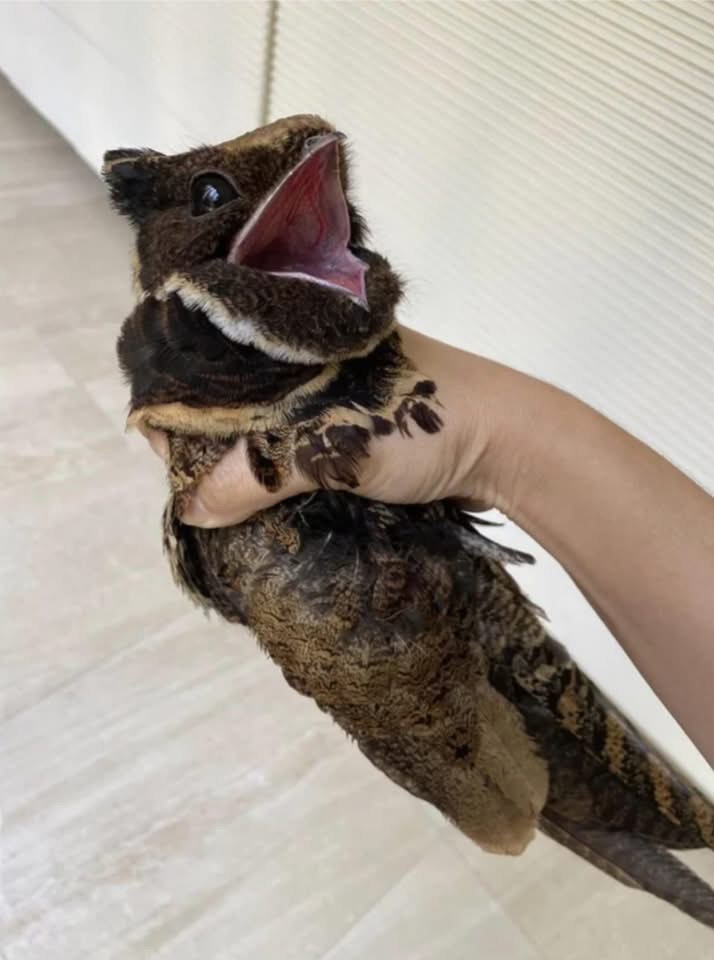The Great Eared Nightjar is one of nature’s most fascinating creatures, resembling a baby dragon that could have easily flown out of the How to Train Your Dragon movies. This nocturnal bird, often described as a mythical creature from folklore, is found in the forests of Southwest India and Southeast Asia. Thanks to its exceptional camouflage and unique hunting abilities, the Great Eared Nightjar is a remarkable example of nature’s ingenuity. In this article, we’ll dive deep into the fascinating features of this bird, its habitat, and its place in mythology.
The Great Eared Nightjar: A Winged Mythical Creature
Resembling a mythical creature or dragon from ancient legends, the Great Eared Nightjar (scientific name Lyncornis macrotis) is a nocturnal predator that is often seen as an enigma. Its remarkable appearance, including long ear tufts and a flat, camouflaged head, make it look like something straight out of folklore. Its large mouth, designed for catching insects mid-air, adds to its dragon-like charm.
The Great Eared Nightjar is an elusive bird, often found in dense forest habitats across Southwest India and parts of Southeast Asia. As a member of the Caprimulgidae family, it shares certain features with its relatives, such as the Common Nighthawk and the Eastern Whip-poor-will, but stands out for its distinctive appearance and exceptional hunting skills.
Camouflage and Survival: The Nightjar’s Secret
One of the most fascinating aspects of the Great Eared Nightjar is its ability to blend seamlessly into its environment during the day. This bird’s feathers are patterned in shades of beige, brown, and gray, mimicking the textures of bark, logs, or leaves. During the daylight hours, the bird rests on the ground or on low branches, making it nearly invisible to predators and observers. This camouflage is a critical survival adaptation, allowing the nightjar to rest undisturbed until nightfall.
At night, the bird becomes a skilled aerial predator, using its large, cavernous mouth to catch flying insects such as moths and beetles. The nightjar’s hunting techniques are precise and efficient, making it one of the best insect hunters in the bird world. It’s an excellent example of how evolution has shaped an animal to thrive in its environment.
Distinctive Features: The Long Ears of the Nightjar
The Great Eared Nightjar’s name is derived from its most striking feature: its long, lynx-like ear tufts. These tufts give the bird a distinctive appearance and contribute to its mythical, dragon-like look. The tufts themselves aren’t actual ears but are feather extensions that help the nightjar with camouflage and communication. These ear-like feathers help break up the outline of the bird’s head, allowing it to blend in more effectively with its surroundings when perched.
Additionally, the nightjar has a flat head, which can squish into its surroundings when it’s perched, further enhancing its ability to remain hidden. This adaptation helps it avoid predators and remain unnoticed while resting.
Mythology and History of the Great Eared Nightjar
Throughout history, nightjars have been shrouded in myth and mystery. The Great Eared Nightjar, like many of its relatives, was once referred to as a “goatsucker” due to the belief that it would suckle from livestock, particularly goats. This myth, prevalent in ancient cultures, claimed that the bird drained milk from farm animals during the night. Modern science has debunked this myth, showing that nightjars feed on flying insects rather than milk. However, the goatsucker legend persists in various cultures, showcasing the bird’s mystical allure.
The bird’s scientific name, Lyncornis macrotis, translates to “long-eared lynx bird”, reflecting both its distinctive ear tufts and its mythical nature. This name was first coined in 1831, adding to the bird’s mystique and reinforcing its connection to ancient folklore.
The Role of the Great Eared Nightjar in Ecosystems
The Great Eared Nightjar plays an essential role in its ecosystem by controlling insect populations. As a nocturnal predator, it helps maintain a balance by keeping the numbers of moths, beetles, and other insects in check. This natural pest control is particularly important in agricultural areas where insects can damage crops.
Nightjars are also important indicators of environmental health. Because they depend on healthy forests for their habitat, the presence or absence of these birds can signal the overall condition of local ecosystems. Protecting the habitats of these nocturnal hunters ensures that not only nightjars but also countless other species of plants and animals thrive.
Where to Find the Great Eared Nightjar



The Great Eared Nightjar is primarily found in the forest regions of Southwest India and parts of Southeast Asia, including countries like Thailand, Vietnam, and Malaysia. It prefers dense, forested areas with ample cover for daytime rest and open skies for night hunting. Birdwatchers and nature enthusiasts often travel to these regions to observe the nightjar in its natural habitat, though its elusive nature makes it a challenge to spot.
If you’re interested in learning more about the birdwatching hotspots for nocturnal birds like the Great Eared Nightjar, the World Wildlife Fund (WWF) offers valuable resources on conservation efforts and eco-tourism opportunities.
The Nightjar’s Conservation Status
Currently, the Great Eared Nightjar does not face any immediate threats to its population. However, like many species, it is vulnerable to habitat loss due to deforestation and human encroachment. Conservation efforts in regions where nightjars are found are crucial for preserving their habitats and ensuring their survival. Organizations like BirdLife International BirdLife International work tirelessly to protect these and other bird species through habitat preservation and awareness campaigns.
Conclusion: The Enigmatic Great Eared Nightjar
The Great Eared Nightjar is a living example of nature’s ability to create mythical, dragon-like creatures that seem to transcend reality. With its exceptional camouflage, hunting prowess, and distinctive ear tufts, it’s no wonder this bird has captured the imagination of people around the world. Though it may seem like something from a fantasy story, the nightjar is very much real and plays an important role in its ecosystem.
From its fascinating physical features to its place in folklore, the Great Eared Nightjar is a bird that continues to intrigue and inspire. Whether you’re a birdwatcher, nature enthusiast, or simply a lover of mythical creatures, this unique bird is a testament to the wonders of the natural world. For more information about nocturnal birds and wildlife conservation, explore resources from National Geographic and The Cornell Lab of Ornithology.
Image Credits:
- Image 1: C. Susanth Kumar
- Image 3: @fly_with_jenisha
